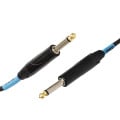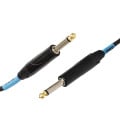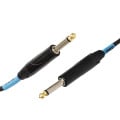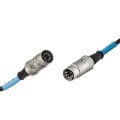- Opis
-
Szczegóły
PROMOCJA: Novation Launchkey Mk3 GRATIS!
Kup Waldorf Iridium w sklepie Supersound, a w ramach akcji Kupuj w polskich sklepach muzycznych otrzymasz kontroler MIDI Novation Launchkey Mk3 całkowicie za darmo!
To wyjątkowy duet kreatywności – wystarczy połączyć oba urządzenia za pomocą kabla USB i zacząć grać, nagrywać i tworzyć bez ograniczeń.
⏳ Promocja trwa od 1 lipca do 30 września 2025 lub do wyczerpania zapasów.
Nie przegap – liczba zestawów promocyjnych jest ograniczona!
Waldorf Iridium – nowa era syntezy w kompaktowej formie
Waldorf Iridium to syntezator, który przenosi potężny silnik syntezy Quantum do kompaktowego formatu desktopowego. Oferując aż 16 głosów polifonii, pięć silników syntezy i pełną kontrolę nad każdym parametrem, Iridium redefiniuje, czym może być instrument elektroniczny w studiu i na scenie.
Najważniejsze cechy
- 16-głosowa polifonia – dwa razy więcej niż w Quantum
- 3 oscylatory stereo na każdy głos
- 5 trybów syntezy: Wavetable, Waveform (VA), Particle (Sample & Granular), Resonator, Kernels
- 3 cyfrowe filtry stereo na głos z różnymi modelami filtrów (Nave, Largo, PPG, State Variable, Quantum)
- 16 padów w układzie 4×4 do wyzwalania nut, akordów, arpeggio i sekwencji
- 6 LFO, 6 obwiedni, Komplex Modulator
- Zaawansowana matryca modulacji z 40 slotami
- 5 slotów efektów (chorus, flanger, phaser, reverb, overdrive, EQ, compressor)
- Sekwencer krokowy i polifoniczny aftertouch (MIDI)
- Import i eksport presetów, sampli i ustawień z kart microSD i pamięci USB
Potężny silnik syntezy
Iridium korzysta z tego samego silnika syntezy co flagowy Quantum. Każdy z trzech oscylatorów może działać w jednym z pięciu trybów: Wavetable do dynamicznych zmian fal, Waveform dla klasycznej syntezy analogowej, Particle do próbkowania i granularnej manipulacji, Resonator do bogatych tekstur harmonicznych oraz Kernels pozwalający jednemu oscylatorowi stać się zestawem sześciu sub-oscylatorów połączonych przez FM lub AM.
Elastyczne filtry i sekcja efektów
Każdy głos posiada trzy cyfrowe filtry stereo, które mogą działać w różnych kombinacjach LP, HP, BP i Notch. Do dyspozycji użytkownika są modele filtrów znane z innych instrumentów Waldorf – m.in. Nave, Largo czy PPG. Sekcja Digital Former oferuje dodatkowe narzędzia jak bitcrusher, ring modulation czy drive. Iridium ma też pięć slotów efektów z możliwością dowolnego routingu.
Modulacja i kontrola
Dzięki sześciu LFO, sześciu obwiedniom, Komplex Modulatorowi i 40-slotowej matrycy modulacji, użytkownik ma pełną kontrolę nad każdym parametrem dźwięku. Dodatkowo 16 padów w układzie 4×4 pozwala wyzwalać akordy, sekwencje lub nuty, co czyni Iridium idealnym narzędziem również do występów live.
Przyjazny interfejs użytkownika
Wszystkie główne parametry mają dedykowane pokrętła na panelu, a pozostałe funkcje obsługiwane są przez czytelny ekran dotykowy o wysokiej rozdzielczości. Workflow został zaprojektowany tak, aby maksymalnie ułatwić pracę i zminimalizować konieczność „przeklikiwania się” przez menu.
Różnice względem Waldorf Quantum
- 16 głosów polifonii (Quantum – 8)
- 16 padów zamiast 61-klawiszowej klawiatury
- Cyfrowe filtry stereo zamiast analogowych
- 2 wyjścia audio zamiast 4
- Dodatkowe wejścia CV do modulacji parametrów
Dane techniczne
- 16-głosowa polifonia, duo-timbral
- 3 oscylatory stereo na głos, każdy z 5 trybami syntezy
- 3 filtry stereo na głos (12/24 dB LP/HP/BP)
- 6 LFO, 6 obwiedni, Komplex Modulator
- 40-slotowa matryca modulacji
- Polifoniczny aftertouch przez MIDI
- Sekwencer krokowy, arpeggiator
- 5 slotów efektów z routingiem równoległym i szeregowym
- Import/eksport presetów i sampli przez USB i microSD
Złącza
- 2× stereofoniczne wyjście audio TS
- 2× stereofoniczne wejście audio TS
- Wyjście słuchawkowe z regulacją głośności
- DIN MIDI In, Out, Thru
- USB typu A (host), USB typu B (device)
- Wejście microSD
- 4 konfigurowalne wejścia CV
- Gate In, Trigger In, Clock In/Out
Budowa i design
Iridium posiada solidną metalową obudowę, wysokiej klasy konwertery 24-bitowe A/D i D/A oraz czytelny kolorowy ekran dotykowy. Dzięki kompaktowym wymiarom i integracji z MIDI oraz CV, instrument idealnie sprawdza się w studiu i na scenie.
Podsumowanie
Waldorf Iridium to nowoczesny syntezator desktopowy oferujący wszystkie możliwości flagowego Quantum, a jednocześnie kompaktowy i przystępny w użytkowaniu. To narzędzie dla profesjonalistów, którzy oczekują maksymalnej swobody w kreacji brzmienia i doskonałej jakości wykonania.
- Dostawa
-
Szczegóły dostawy produktu Waldorf IRIDIUM - Syntezator + Novation Launchkey 37 mk3 gratis !!!
Wysyłka z Warszawa, Polska.
Dostawa do
Jeżeli chcesz zobaczyć dokładne metody dostawy dostępne w Twojej lokalizacji, uzupełnij powyższe pola.
- Zadaj pytanie
-
Zadaj pytanie odnośnie produktu
- Produkt faq
-
Waldorf IRIDIUM - Syntezator + Novation Launchkey 37 mk3 gratis !!! - Najczęściej zadawane pytania.
Czym różni się Waldorf Iridium od Quantum?
Iridium oferuje 16 głosów polifonii (Quantum – 8), cyfrowe filtry stereo, 16 padów zamiast klawiatury, 2 wyjścia audio i dodatkowe wejścia CV.
Ile głosów polifonii oferuje Iridium?
16 głosów polifonii z możliwością pracy duo-timbral.
Jakie tryby syntezy są dostępne?
Wavetable, Waveform (VA), Particle (Sample & Granular), Resonator oraz Kernels.
Czy Iridium obsługuje polifoniczny aftertouch?
Tak, poprzez MIDI dostępny jest polifoniczny aftertouch.
Czy można wgrywać własne próbki?
Tak, przez wejścia audio, USB oraz karty microSD można importować próbki i presety.
Czy Iridium posiada sekwencer?
Tak, wbudowany sekwencer krokowy pozwala programować nuty i parametry.
Ile slotów efektów jest dostępnych?
5 slotów z efektami takimi jak chorus, reverb, flanger, phaser, EQ, compressor i drive.
Jakie złącza oferuje Iridium?
2× audio out, 2× audio in, MIDI DIN, USB A/B, microSD, wyjście słuchawkowe, 4 CV In, Gate/Trigger/Clock In/Out.
- Recenzje (0)
-
0.0
0 recenzji
Oceń ten produkt jako pierwszy
O producencie Waldorf

Firma Waldorf Music GmbH została założona w roku 1988 przez Wolfganga Dürena. Siedziba firmy Waldorf Music GmbH znajduje się w Waldorf (D).
Produkty firmy Waldorf produkowane są wyłącznie w Niemczech.
Firma
- Siedziba producenta: Niemcy
- Średnia ocena produktów: 5.0
Produkty
- Liczba produktów: 16
- Liczba dostępnych produktów: 11




















